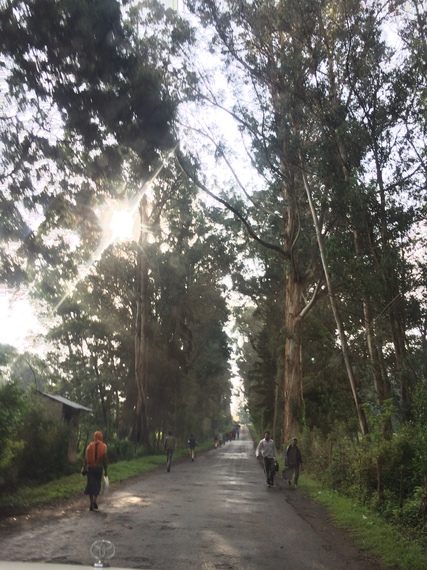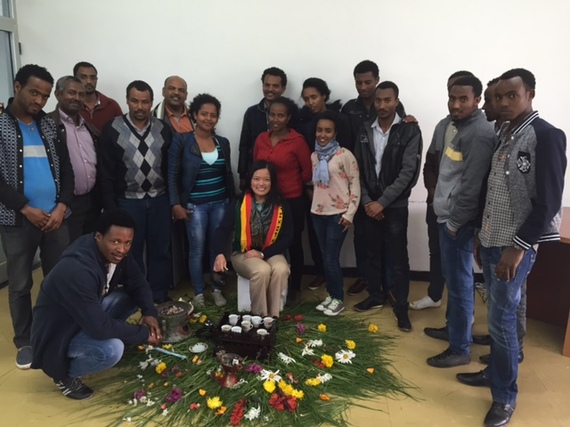There are hundreds of stories I could tell from my recent trip to Ethiopia four months ago-- stories of similarities and differences, of opportunity and challenges. But I want to focus here on the reason for my trip and what I hope I accomplished.
I went to Ethiopia on a volunteer trip, funded by the United States Agency for International Development (USAID) and facilitated by Catholic Relief Services (CRS) on a Farmer-to-Farmer technology-transfer assignment. The immediate goal for volunteers is to offer education and hands-on training to farmers and researchers in developing countries. The ultimate goal for USAID and CRS, and a goal I share, is to alleviate poverty by increasing agricultural productivity.
These are big challenges for Ethiopia. According to the World Bank Group's latest assessment, 30 percent of the population was impoverished in 2011, the last year for which statistics were available. Meanwhile, the population is growing fast. It stands today at more than 95 million, making Ethiopia the 13th most populous country in the world. And by 2050, that figure is expected to balloon to nearly 190 million.
Yet Ethiopia has been making progress in reducing poverty. The 30 percent rate of 2011 represents a sharp improvement from the 44 percent rate in 2000. Over the past 20 years, the portion of the population that is undernourished has fallen to 30 percent from 70 percent.
The main driver of these improvements has been agricultural growth, the World Bank Group says. But more improvement is clearly needed. As I observed, farmers in Ethiopia still use oxen to plow their fields and only the lucky few have donkeys to transport their goods to market. Soil degradation, deforestation, overgrazing, and many other problems impacting agricultural productivity are severe.
Advancements in plant sciences could help minimize this productivity gap.
As a volunteer, my assignment was to teach students how to apply new fields of science like genomics and bioinformatics to their line or work. My students were an impressive group. The first biotechnologists in Ethiopia, they all had either bachelor or master degrees in plant, animal, or microbial biotechnology. Some were working toward a PhD. All were eager to learn. I felt it was a real privilege to work with them.
The technical training they wanted most was "how to take the petri dish to the field." This is a challenge I deal with everyday in my day job at Monsanto - how to use what we learn in the lab or with big data to improve crop production for farmers.
I started with quantitative genetics, experimental design, and selection strategies in plant breeding. That background is necessary to estimate the genetic potential of the populations studied - and thus to understand the capacity for big improvements. I then showed them how to identify statistical-based associations between molecular markers using wet-lab techniques. With these techniques, we can identify DNA sequences in select plants that correspond to a field-based phenotype, a measurable or visible trait of interest. We then discussed the newest next-generation technologies, which are providing even more robust data to leverage.
It was a huge challenge to cover all this in two weeks, but they asked for all of it. I basically offered them a download of everything I'd learned over the past 15 years through my academic courses and research. But for all I shared, I was left wondering, was it enough? Should I have done something different? Had I been the right person for this job?
There were 44 scientists trained, mostly new recruits right out of college. Some were junior researchers working toward a Ph.D. and few were more senior, already having earned their doctorates and leading different programs. Nine were women, some with leadership roles in the lab. I connected with these women, and I saw much of myself in them, balancing career and family with focus and hard work.
I'm hopeful I was able to transfer my knowledge and expertise in increasing agricultural productivity, so that with added resources and time their projects can eventually succeed.
I also left with an even greater love for how science can bring people together and inspire them. Ideas are shared, relationships are made, and hope seeps in and affects how you think about the world. Now I look forward to continued interaction with my new friends and to maintaining the momentum that will enable us, together, to find ways to close the agricultural productivity gap.

